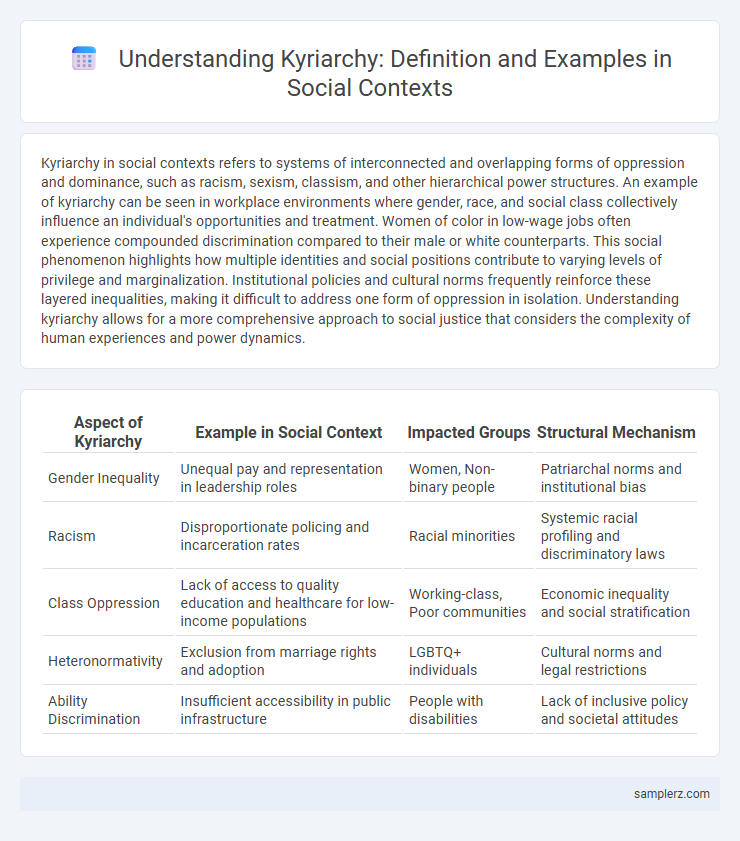Kyriarchy in social contexts refers to systems of interconnected and overlapping forms of oppression and dominance, such as racism, sexism, classism, and other hierarchical power structures. An example of kyriarchy can be seen in workplace environments where gender, race, and social class collectively influence an individual's opportunities and treatment. Women of color in low-wage jobs often experience compounded discrimination compared to their male or white counterparts. This social phenomenon highlights how multiple identities and social positions contribute to varying levels of privilege and marginalization. Institutional policies and cultural norms frequently reinforce these layered inequalities, making it difficult to address one form of oppression in isolation. Understanding kyriarchy allows for a more comprehensive approach to social justice that considers the complexity of human experiences and power dynamics.
Table of Comparison
| Aspect of Kyriarchy | Example in Social Context | Impacted Groups | Structural Mechanism |
|---|---|---|---|
| Gender Inequality | Unequal pay and representation in leadership roles | Women, Non-binary people | Patriarchal norms and institutional bias |
| Racism | Disproportionate policing and incarceration rates | Racial minorities | Systemic racial profiling and discriminatory laws |
| Class Oppression | Lack of access to quality education and healthcare for low-income populations | Working-class, Poor communities | Economic inequality and social stratification |
| Heteronormativity | Exclusion from marriage rights and adoption | LGBTQ+ individuals | Cultural norms and legal restrictions |
| Ability Discrimination | Insufficient accessibility in public infrastructure | People with disabilities | Lack of inclusive policy and societal attitudes |
Unpacking Kyriarchy: Social Hierarchies Defined
Kyriarchy manifests in social contexts through interconnected systems of domination such as patriarchy, racism, and classism, which collectively enforce unequal power structures. This multilayered hierarchy perpetuates privilege for dominant groups while marginalizing intersecting identities based on gender, race, socioeconomic status, and sexuality. Understanding kyriarchy enables a comprehensive analysis of systemic oppression beyond single-axis frameworks of inequality.
Intersectionality: Layers of Oppression in Society
Kyriarchy manifests in social settings through overlapping systems of oppression such as racism, sexism, classism, and ableism that interact to marginalize individuals differently based on their intersectional identities. For example, women of color often face compounded discrimination due to both racial and gender biases, intensifying social exclusion and economic inequality. This layered oppression reveals the complexity of power structures that cannot be addressed by single-issue frameworks alone.
Kyriarchy in Gender Relations and Norms
Kyriarchy in gender relations manifests through institutionalized hierarchies that privilege cisgender men while marginalizing women, non-binary, and transgender individuals, perpetuating unequal power dynamics. Social norms enforcing rigid binary gender roles reinforce these disparities by limiting access to opportunities, resources, and rights based on gender identity and expression. This systemic oppression affects domains such as workplace representation, healthcare access, and legal protections, maintaining structural inequality within society.
Race, Power, and Kyriarchal Structures
Kyriarchy manifests in social contexts through systemic racial hierarchies where power is concentrated among dominant racial groups, perpetuating oppression and marginalization of minorities. Institutions such as law enforcement and education often reinforce these racialized power imbalances by privileging dominant cultural norms and practices. This interlocking system of race and power sustains kyriarchal structures, limiting social mobility and equality for marginalized racial communities.
Economic Class and Social Mobility Barriers
Economic class significantly shapes individuals' access to resources, creating persistent social mobility barriers within kyriarchal systems. Low-income groups often face systemic obstacles such as limited educational opportunities, job discrimination, and unequal access to capital, reinforcing socioeconomic disparities. These intersecting oppressions within economic hierarchies perpetuate exclusion and hinder upward mobility across generations.
Religion as a Tool for Kyriarchal Control
Religious institutions often reinforce kyriarchal hierarchies by promoting doctrines that legitimize gender, class, and racial inequalities. Patriarchal interpretations of sacred texts are used to justify exclusion and subordination of marginalized groups, consolidating power within dominant social classes. Rituals and religious leadership roles typically privilege men, perpetuating systemic oppression and limiting social mobility for others.
The Role of Media in Perpetuating Kyriarchy
Media outlets often reinforce kyriarchal structures by disproportionately representing dominant groups while marginalizing or stereotyping minorities, thus maintaining intersecting systems of oppression. News coverage tends to prioritize narratives that support existing power hierarchies, such as racial, gender, and class privileges, limiting diverse perspectives. This biased representation shapes public opinion and normalizes social inequalities embedded in kyriarchy.
Disability and Marginalization within Kyriarchal Systems
Disability within kyriarchal systems often leads to multiple layers of marginalization, where societal structures privilege able-bodied norms and exclude disabled individuals from full participation. This systemic exclusion manifests in limited access to employment, education, and public spaces, reinforcing social hierarchies that marginalize disabled voices. Intersectional oppression intensifies when disability intersects with other identities such as race, gender, or class, compounding discrimination and social invisibility.
Sexual Orientation and Systemic Social Exclusion
Kyriarchy manifests in social systems through the systemic exclusion of non-heteronormative sexual orientations, where LGBTQ+ individuals face discrimination in employment, healthcare, and legal rights. Heterosexism entrenches power imbalances by privileging heterosexual identities, leading to social marginalization and limited access to resources for queer communities. The intersection of sexual orientation and systemic social exclusion reinforces hierarchical oppression embedded within institutional policies and cultural norms.
Strategies for Challenging Kyriarchy in Everyday Life
Challenging kyriarchy in everyday social contexts involves fostering inclusive dialogue that recognizes intersecting oppressions such as race, gender, and class. Engaging in active allyship through amplifying marginalized voices and participating in community-based activism dismantles hierarchical power structures. Practicing critical self-reflection to identify and interrupt internalized biases creates spaces for equitable social interactions and systemic change.

example of kyriarchy in social Infographic
 samplerz.com
samplerz.com